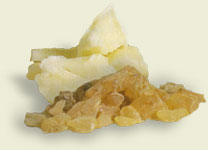
Clump of resin that can be dissolved in spirits, and used as a varnish.
In a 15th century artist’s handbook, Cennino Cennini writes that varnishing makes a painting’s colors "become very fresh and beautiful, and remain in pristine state forever… The secret of the best and most beautiful kind of varnish is this: the longer you delay after the paintings is completed, the better it is."
Varnish is resin dissolved in spirits (volatile solvents) that evaporate as the varnish dries. It imparts a brilliant finish, intensifying color contrast, as a brick building appears darker after a rainshower.
Varnish protects a painting for centuries, shielding it from dirt and ultraviolet light. In absorbing ultraviolet light, however, the varnish photo-oxidizes and turns yellow. The yellowed varnish can be removed with solvents, revealing the original painting, which is then revarnished. Shown at right is the Feast of the Gods before and after it was cleaned by the National Gallery of Art in 1985—1989.
